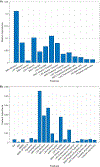Presynaptic Dopaminergic Imaging Characterizes Patients with REM Sleep Behavior Disorder Due to Synucleinopathy
- PMID: 38466158
- PMCID: PMC11102309
- DOI: 10.1002/ana.26902
Presynaptic Dopaminergic Imaging Characterizes Patients with REM Sleep Behavior Disorder Due to Synucleinopathy
Abstract
Objective: To apply a machine learning analysis to clinical and presynaptic dopaminergic imaging data of patients with rapid eye movement (REM) sleep behavior disorder (RBD) to predict the development of Parkinson disease (PD) and dementia with Lewy bodies (DLB).
Methods: In this multicenter study of the International RBD study group, 173 patients (mean age 70.5 ± 6.3 years, 70.5% males) with polysomnography-confirmed RBD who eventually phenoconverted to overt alpha-synucleinopathy (RBD due to synucleinopathy) were enrolled, and underwent baseline presynaptic dopaminergic imaging and clinical assessment, including motor, cognitive, olfaction, and constipation evaluation. For comparison, 232 RBD non-phenoconvertor patients (67.6 ± 7.1 years, 78.4% males) and 160 controls (68.2 ± 7.2 years, 53.1% males) were enrolled. Imaging and clinical features were analyzed by machine learning to determine predictors of phenoconversion.
Results: Machine learning analysis showed that clinical data alone poorly predicted phenoconversion. Presynaptic dopaminergic imaging significantly improved the prediction, especially in combination with clinical data, with 77% sensitivity and 85% specificity in differentiating RBD due to synucleinopathy from non phenoconverted RBD patients, and 85% sensitivity and 86% specificity in discriminating PD-converters from DLB-converters. Quantification of presynaptic dopaminergic imaging showed that an empirical z-score cutoff of -1.0 at the most affected hemisphere putamen characterized RBD due to synucleinopathy patients, while a cutoff of -1.0 at the most affected hemisphere putamen/caudate ratio characterized PD-converters.
Interpretation: Clinical data alone poorly predicted phenoconversion in RBD due to synucleinopathy patients. Conversely, presynaptic dopaminergic imaging allows a good prediction of forthcoming phenoconversion diagnosis. This finding may be used in designing future disease-modifying trials. ANN NEUROL 2024;95:1178-1192.
© 2024 The Authors. Annals of Neurology published by Wiley Periodicals LLC on behalf of American Neurological Association.
Figures


References
-
- Doppler K, Antelmi E, Kuzkina A, et al. Consistent skin α-synuclein positivity in REM sleep behavior disorder - A two center two-to-four-year follow-up study. Parkinsonism Relat Disord. 2021. May;86:108–13. - PubMed
-
- Iranzo A, Fairfoul G, Ayudhaya ACN, et al. Detection of α-synuclein in CSF by RT-QuIC in patients with isolated rapid-eye-movement sleep behaviour disorder: a longitudinal observational study. Lancet Neurol. 2021. Mar;20(3):203–12. - PubMed
-
- Galbiati A, Verga L, Giora E, Zucconi M, Ferini-Strambi L. The risk of neurodegeneration in REM sleep behavior disorder: A systematic review and meta-analysis of longitudinal studies. Sleep Med Rev. 2019. Feb;43:37–46. - PubMed
-
- Hoglinger GU, Adler CH, Berg D, et al. A biological classification of Parkinson’s disease: the SynNeurGe research diagnostic criteria. Lancet Neurol. 2024. Feb;23(2):191–204. - PubMed
Publication types
MeSH terms
Grants and funding
- AG62677/Foundation for the National Institutes of Health
- Monument Trust Discovery Award from Parkinson's UK
- P50 AG016574/AG/NIA NIH HHS/United States
- VEGA 1/0712/22/Slovak Scientific Grant Agency
- NS100620/Foundation for the National Institutes of Health
- Ministero della Salute
- GE Healthcare
- AG071754/Foundation for the National Institutes of Health
- R34 AG056639/AG/NIA NIH HHS/United States
- Mayo Clinic Dorothy and Harry T. Mangurian Jr. Lewy Body Dementia Program
- LX22NPO5107/National Institute for Neurological Research
- Little Family Foundation
- Ministero dell'Università e della Ricerca
- U19 AG071754/AG/NIA NIH HHS/United States
- AG056639/Foundation for the National Institutes of Health
- P30 AG062677/AG/NIA NIH HHS/United States
- Ted Turner and Family Foundation
- APVV-22-0279/Agentúra na Podporu Výskumu a Vývoja
- NU21-04-00535/Czech Ministry of Health
- National Institute for Health and Care Research
- AG016574/Foundation for the National Institutes of Health
- APVV-18-0547/Agentúra na Podporu Výskumu a Vývoja
- U01 NS100620/NS/NINDS NIH HHS/United States

